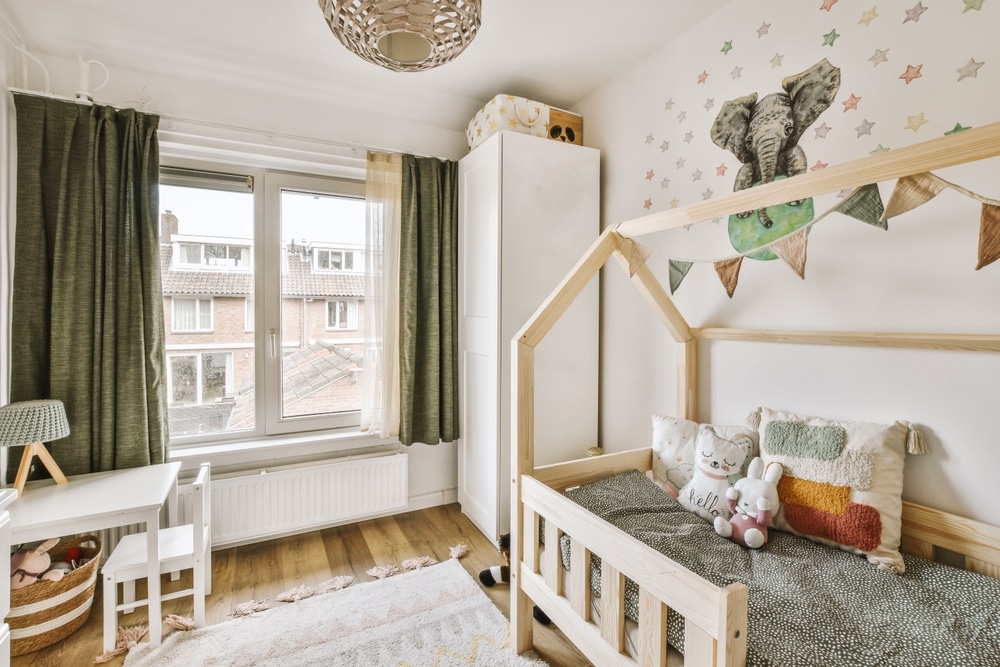When creating a safe sleep environment for your baby, one of the most important rules is never to place their Crib in Front of the window. This can create an unsafe sleeping area that could put your baby at risk. Placing the crib in front of the window can be dangerous for several reasons.
The first reason is that windows pose potential hazards due to cords from blinds and draperies that can become entangled around your little one’s neck and cause strangulation. Additionally, if you have open windows in the room during warmer months, there is also a risk of falls since babies are often curious and like to explore by climbing around their cribs. Lastly, if you have large windows with direct sunlight, this could disturb your baby’s sleep cycle due to bright lights entering the room throughout the day.
Is it dangerous to put a bassinet or crib in front of the window?
Cribs and bassinets are two of the essential pieces of furniture used in a baby’s nursery. However, many parents are unaware that placing a bassinet or crib in front of a window may harm their child.
When placed near an open window, an infant’s risk of serious injury is significantly increased. Without proper safety devices installed on the windowsill, there is a greater chance that they can pull themselves up and fall out of the window.
Furthermore, it has been shown that direct sunlight and draft can be hazardous for babies because they have not yet developed their regulating systems. Parents should take extra precautions when deciding where to put their baby’s crib or bassinet.
Cords are also a strangulation hazard.
Cords are a strangulation hazard, especially when they’re left dangling down in a crib. While it may seem common sense to keep cords out of reach of the crib, many people don’t realize that even the best intentions can have unintended consequences. For example, if you place your baby’s crib in front of the window, the blinds or curtains can have long cords that a curious baby could easily reach.
If your child’s crib is near a window with curtains or blinds, never leave the cord within reach, as it poses an extreme choking and strangulation hazard for children under 12 months old. To prevent these accidents from happening, be sure to secure any cords high up on walls where your child cannot access them; you can use special hooks or clips for added security.
Blinds and curtain rods can fall on a child.
Most parents want to provide a safe and secure environment for their children, and having the right window treatments is integral. Unfortunately, blinds and curtain rods can fall on a child if not properly secured. Cribs in front of windows can put babies at even greater risk if not adequately protected.
Parents should take extra care when placing cribs in front of windows with blinds or curtains. Blind cords should be cut short, so they do not hang lower than five inches above the floor, and curtain rods should be securely attached to the wall above the crib at all times. Installing cord wind-ups or tension devices is also recommended to keep loose cords out of reach from infants. Additionally, metal Venetian-style blinds should be avoided as their slats pose a choking hazard for young children.
Can a crib be against a wall?
When it comes to safe sleep practices for babies, the first question many parents ask is, “Can a crib be against a wall?” It’s natural to want the crib in a prominent position in the nursery, but safety must come first. Cribs should never be placed against walls because of hazards such as cords and outlets that could present a strangulation risk.
However, one exception to this rule is if you place the crib in front of a window. This allows for natural light during nap time and ventilation from an open window on hot days. When placing a crib in front of a window, ensure it is at least two feet away from any curtains or blinds; this will help prevent your little one from getting tangled up in them.
Should you hang things above the crib?
When decorating a nursery, one of the most common questions parents ask is whether they should hang items from above the crib. This decision has pros and cons, and it ultimately depends on the situation. For example, parents may want to avoid hanging anything for safety reasons if the crib is in front of a window.
On the one hand, hanging decorations can add warmth and personality to a nursery. The right pieces can help create an inviting atmosphere where the baby will enjoy spending time. However, when there’s a window nearby, these items can pose a hazard if they fall onto the baby while they sleep. Try mounting wall art or shelves at least three feet away from the crib so that nothing hangs directly over the baby’s head while sleeping.
Where should a crib be placed in a room?
Placing a crib in front of the window can be a great way to bring natural light into your baby’s nursery. Natural light is known to have calming and soothing effects, which can help promote good sleep habits and provide a more relaxed atmosphere. However, there are some essential safety considerations you should consider when deciding whether to place your baby’s crib in front of the window.
The most important factor when choosing where to place your baby’s crib is ensuring that it is at least three feet away from any windows or doors. This helps to minimize the risk of accidental falls due to an open window or door being left unattended. It also helps reduce potential exposure to drafts or cold air coming through an open window during winter months.
Next to the door:
When planning a nursery, the crib is often the center of attention. Where you place can significantly affect how well you and your baby sleep. A popular choice for many parents is to identify the crib right next to the door. This gives easy access when entering or leaving the room and provides peace of mind that your little one will be within reach at all times.
But what if you want to put your crib in front of the window? Although it can help create a beautiful view for both parent and child, there are some important safety considerations to consider first. Make sure there’s no direct sunlight streaming, which could overheat the baby or damage furniture. Ensure there’s no risk of cords from curtains or blinds being reached by curious hands.
Diagonally in a corner:
When decorating your nursery, there’s one element you absolutely cannot overlook — the crib. Where you place the crib can significantly impact the look and feel of the room. And when it comes to making an impactful design statement, what better way to do it than by placing the crib diagonally in a corner in front of a window?
This eye-catching placement looks unique and creates an intimate space for your little one. With this setup, babies and parents can observe their beautiful outdoor views while napping or spending quality time together. By angling your crib this way, you’re creating a cozy nook that will draw everyone in and make them feel relaxed.
In the middle of the room:
In the middle of any room stands a crib, that special place where a child rests and dreams. But when that crib is placed in front of a window, it can become much more.
Positioning the crib in front of the window allows natural light to enter during the day and provides soothing moonlight at night. Not only does this bring comfort to an infant, but it also adds aesthetic value to any room’s interior design. With soft curtains or shades blocking out direct sunlight, the warm glow from outside casts a perfect amount of light into any nursery. Having one part of the room focus on nature could even be argued to provide some form of psychological comfort for parents and children alike.
Conclusion:
The risks of placing a crib in front of the window are too significant to ignore. While it may seem like a picturesque way to brighten up a nursery, the potential for harm far outweighs any aesthetic benefits. Parents should consider all safety guidelines for crib placement and ensure their child’s crib is in an area free from potential hazards. Keeping the crib away from a window is essential for keeping your baby safe, healthy, and secure.
Read more….








